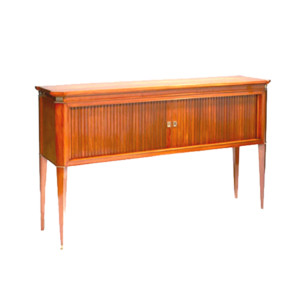(1918 – 1992)
There were many very talented furniture designers working in France in the 1940’s – 50’s, and after, but one name stands out – Jacques Quinet – the excellence of his work. The career of Jacques Quinet is difficult to define, as it spanned over five decades, and several radically different styles. It is a tribute to Quinet’s genius that he was so successful at navigating so many changes without compromising his work. He consistently produced designs with his characteristic elegance of line, deceptive simplicity, and perfect proportions.
Quinet was a decorator, furniture maker, and architect. He studied architecture, but had to interrupt his studies when he was mobilized to fight in WW2. Following his de-mobilization in 1946, he once again resumed his architecture studies, and, fortuitously, was introduced to a master cabinet-maker in the famed Faubourg St. Antoine – then the center for fine cabinet-work in France. It was here that he absorbed the tradition of the finest French furniture. He did not wish, however, to simply design furniture – his desire was to develop a distinctive style. His designs, while making reference to earlier and more traditional forms, were lighter, sleeker, and more modern. He began with a geometric drawing, and from there, worked to refine it, eliminating any un-necessary ornament, and the resulting pieces had a deceptive lightness, and were luxurious by virtue of their materials and elegant proportions.
When furniture designs are so pared down, the proportions must be perfect – there is no ornamentation to hide behind. The volume must appear light, even for larger pieces. One of Quinet’s great gifts was his prefect sense of proportion, developed, no doubt, through his training as an architect. He also had a fine sense of color, and used beautiful lacquered surfaces to enhance many of his pieces. This emphasis on refined structure and lightness also contributed to his success as an architect.
Another important aspect of Quinet’s furniture was his use of bronze. Quinet began by using bronze for simple ornamentation, but soon, the bronze elements came to define the forms of his pieces, and later, bronze asserted itself as the defining element of his work.
After 1947, Quinet participated in many important exhibitions – Art et Industrie, Siège au Pavillion de Marsan, Salon des Artistes Décorateurs, and others in France and abroad. He was soon securely established in Paris as one of the great talents of his time. He attracted many wealthy and important private clients, many of whom were his personal friends, designing furniture in his distinctive and elegant style, utilizing rare woods, such as sycamore, mahogany and cherry wood, and also beautiful lacquer surfaces, with bronze accents. He was honored to receive requests for his furniture for the prestigious Mobilier National, and in 1951, he decorated the residence of General Eisenhower at Marne-la-Coquette.
As his reputation grew, he received more important commissions. He was asked to design the Head Offices and Director’s Suites for such firms as Krema (19430, Larousse (1947), la societé des Eaux d’ Evian (1955 – 1964), Air France (1965), and Beghin-Say(1969), among many others.
He also received commissions for the design and decoration of the First Class cabins, smoking room, and dining room for the steamship LA BOURDONNAISE, in 1953, the liner FRANCE, in 1962 and the PASTEUR, in 1966. These are only a few of the boats that Quinet designed for. In addition, he was in charge of the decoration for the famed Hotel Plaza Athénée in Paris in 1968.
Quinet did not stop with boats – he designed the interior of the CARAVELLE for Air France in 1965, the MIRAGES for Dassault (1970 – 1973), as well as trains for the SNCF. He created the Turbo-trains for railroads in Egypt, Morocco, and the Ivory Coast. It is quite amazing to realize how versatile his genius was.
Jacques Quinet received many honors. In 1985, he was named Chevalier des Arts et des Lettres, and was made an Officier in 1988. He was decorated by the Légion d’Honneur in 1990.
The furniture of Jacques Quinet is highly sought-after by discerning decorators and collectors, and his furniture rarely appears on the market, possibly because the families for whom he originally designed pieces have kept them.
After an illustrious career, Jacques Quinet died on October 31, 1992.
Showing the single result


